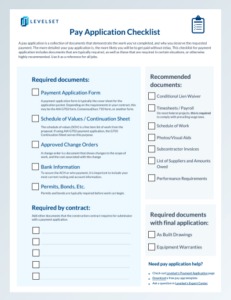
Applying for payment is a process that every contractor must understand from A to Z. In construction, a payment application is the document (or more accurately, packet of documents) that a contractor submits to get paid for their services. A contractor must clearly understand what documents and back-up information they need to supply with their application for payment. This article provides a checklist for payment application documents, including those that are required or recommended. We’ll also go into a detailed explanation of each.
Read the contract requirements
Every construction contract has specific requirements and forms that are part of the application for payment. The contract terms will spell out what needs to be turned in with each pay application, and may provide instructions on exactly how, when and to whom to submit it to. Making a mistake on the pay application could mean that you have to wait til next month to get paid.
It is a good idea to provide as much detail as possible in your payment application, even if the contract doesn’t require it. Giving the general contractor or owner a complete picture of the work you’re doing will give you a better chance of getting approval.
An application for payment can take between 10-15 business days to process, and a few more days to get paid. That is, if everything is correct and the GC or owner doesn’t dispute your numbers.
Contractor Document Checklist for a payment application

A complete application for progress payments will include some of the following documents and information. It’s helpful to create a clear document retention policy, so it’s easier to collect and submit these documents each month.
Required Pay Application Documents (Usually)
Payment Application Form
A payment application form is typically the cover sheet for the application packet. It provides a snapshot of the work a contractor completed in the current pay period, associated costs, and the current amount due.
Perhaps the most popular payment application form is the AIA G702 Application for Payment. The AIA form provides a summary of the current contract value, amount completed to date, retainage held to date, amount previously drawn, and the total amount of the current invoice.
There are other forms available that provide the same information. Unless the contract requires it, don’t feel like you have to use an official AIA document. Levelset provides a free payment application form for download. Many software programs will generate similar documents.
Schedule of Values
The schedule of values (SOV) is generally prepared using the specification sections or line items in the proposal. It provides:
- An itemized breakdown of work on the project
- The cost associated with each work item
- Amount of each work item that is complete
- Percentage of work and cost remaining
A simple spreadsheet will usually suffice for this requirement.
If using AIA documents, their G703 Continuation Sheet provides a detailed breakdown of activities or line items adding up to the total contract amount.
Approved Change Orders
A change order is a document that shows changes to the scope of work, and the cost associated with the change. The owner and contractor must both sign the change order. Because the pay application will reflect the change in work and cost, including the change orders gives the GC and owner a quick reference point to confirm that the numbers in the application are correct.
Bank Information
To secure the ACH or wire payment, it is important to include your most current routing and account information. The information can be provided electronically, or as supplemental information to process the payment.
While this may only be a requirement with the initial payment application, it is helpful to provide with every submission.
Permits, Bonds, Etc.
Permits and bonds are sometimes required before work can begin. Other times, they are required along the way to getting the project to be operational. Government permits are needed to start operation of a business, or to obtain final approval. These are project-specific and provided during the permit filing process.
A permit matrix is a good idea and provide line sight of the permits needed during the project. As the project progresses, the permit matrix is updated showing only the outstanding permits to be secured.
Required documents for the final application (usually)
As Built Drawings
The owner or GC will typically request “as builts” with the last invoice or payment request. “As built” drawings capture how things were actually built (in contrast to how they were designed). They are necessary for the project owner to document the actual conditions of the work. The owner often won’t release final payments unless “as builts” have been completed.
Equipment warranties
These owner will generally require warranty documents before they release the final payment. The contractor is responsible for turning over operation manuals, training, warranties, and certificates of insurance for any equipment that they installed. These documents should come directly from the manufacturer or vendor, including all training necessary to operate new equipment.
Recommended documents (if not required)
Conditional Lien Waiver
A lien waiver is a document that a contractor provides to the GC or owner agreeing to waive their right to file a lien in exchange for payment. Provide this document with your payment application, rather than waiting for the hiring party to request it.
A conditional lien waiver states that the contractor waives lien rights only after they receive the requested payment. If the owner doesn’t make the payment, the waiver is invalid.
On progress payments, the contractor will typically use a partial conditional lien waiver. A partial lien waiver is a guarantee that the contractor or supplier will not try to pursue a mechanics lien on the payment amounts so far. It reserves the contractor’s right to file a lien for other amounts they expect in the future.
The owner may require the GC or subcontractor to supply waivers for lower tier subs or suppliers with each application. These prove that you paid them the amounts you owe them.
Learn more: Read the Ultimate Guide to Lien Waivers in Construction.
Timesheets / Payroll Reports
Contractors may need to include timesheets or payroll reports for the current payment cycle as back-up documentation for change orders, or as proof that they are paying workers the stipulated wages. These payment application documents will include the name of each individual, hours worked each day, current rate of pay, and fringe benefits paid to the employee or to a third-party.
This is a required document for most federal projects, to comply with prevailing wage requirements. It is also required on many other state or publicly-funded projects.
Schedule
The contractor may need to include a detailed and updated schedule in Critical Path Method (CPM) format. The schedule indicates milestones and work complete while providing a current snapshot of the final completion date of the project.
You should adjust and update the schedule each month to meet contract requirements. Sometimes, the contractor is asked to have a cost- or resource-loaded schedule instead of CPM. This type of schedule will guarantee that the contractor is forecasting the right resources and material to complete the project.
Photos or Visual Aids
Visual aids provide a quick status on the portion of the work that you’ve completed. Photos, time-lapse videos, and other visual documents are great tools to show work progress with your pay application. Another option is providing updated production sheets indicating the quantities complete. You could also make copies of the plans and mark-up the areas that have been completed during the application period.
The key here is to be as thorough as possible. Visual aids will provide a quick snapshot that shows you completed the work, and supports your request for payment.
Read more about best practices for documenting site work with photos.
Subcontractor Invoices
Subcontractor or vendor invoices provide detailed information about the work they have completed, costs and their current outstanding balance. All work performed by others should have invoices explaining the scope and costs incurred. Subcontractors should follow the same format the GC uses to facilitate the reconciliation process.
List of Suppliers and Amounts Owed
Many times, the company up the pay chain will want to know about your suppliers. They want to know who you owe money to, and how much. They may ask you to complete an affidavit saying who your subs and suppliers are, how much you owe them, and how much you have paid them to date. The purpose of this list is to be aware of all potential lien filers on a project. If a contractor or owner notices a problem with a lower tier sub, they may step in and start issuing joint checks to make sure all the bills get paid.
Performance Requirements
Some contracts will require specific performance requirements for the building or equipment. These requirements might relate to accessibility (e.g. wheelchair ramps), water flow efficiency, security/safety, etc.
The contractor can demonstrate performance requirements by providing documents with their pay application that show how the structure or equipment meets them. These documents also provide a guarantee of successful operation.
A detailed payment application gets paid faster
In order to receive payment faster, contractors should provide as much detail as possible with their payment application. This may include documents that the contract requires, as well as additional documents or visual aids that support the request.
After your initial payment application, reach out to the GC or owner to see if it met their expectations. Ask if they would like to see any additional supporting documentation in the next one. Ultimately, provide what it takes to get them to approve your pay app quickly.
